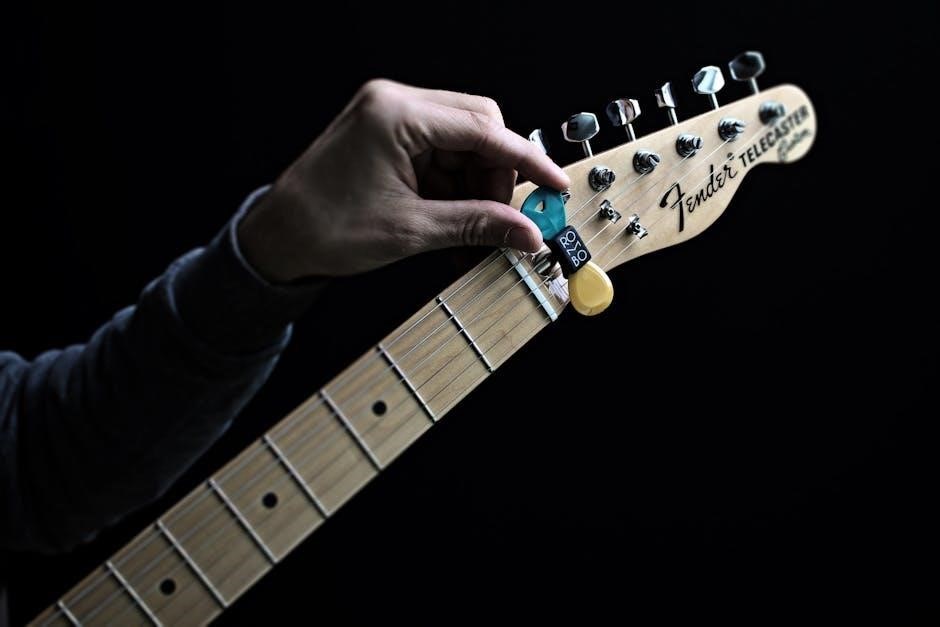Choosing the right strings for your Telecaster can significantly impact its sound and playability. This guide explores various string gauges, materials, and brands to help you find the perfect set for your Tele.
Telecasters, renowned for their bright and twangy sound, are versatile guitars favored across genres. Selecting the right strings is crucial to maximizing your Tele’s potential. Strings influence tone, playability, and overall feel, making the choice a personal one. Most Telecasters ship with 9-42 gauge strings, a popular choice.
Experimenting with different gauges, materials, and brands is essential to discovering what works best for your playing style. Whether you prefer lighter strings for easier bends or heavier strings for a fuller sound, understanding the options available will help you achieve your desired tone on your Telecaster.

String Gauge Overview
String gauge refers to the thickness of the strings, impacting playability and tone. Lighter gauges are easier to bend, while heavier gauges offer a fuller, more resonant sound.
Common String Gauges for Telecasters
Telecasters are commonly strung with 9-42 or 10-46 gauge strings, offering a balance between playability and tone. 9-42s are lighter, making bending easier, while 10-46s provide a fuller sound with more sustain. Many players find 9-42 gauge strings to be comfortable, especially newer guitarists. They are also easier to produce and more common for guitarists. Some prefer hybrid gauges like 9.5-44, which offer a compromise between the two. Ultimately, the best gauge depends on your playing style and preferences, experimentation is key to finding the perfect fit.
9-42 Gauge Strings
The 9-42 gauge string set, often called “super light,” is a popular choice for Telecasters. This gauge offers lower tension, enhancing playability and making bends easier, which is especially beneficial for beginners. Many electric guitars ship with 9-42 nickel-plated strings. While they are comfortable and easy to play, the 9-42 gauge may lack the tonal fullness of heavier gauges. Players prioritizing comfort and ease of play often prefer 9-42s. Ernie Ball Super Slinkys are a popular and affordable option in this gauge, making them a great starting point for exploring string options.
10-46 Gauge Strings
The 10-46 gauge string set is a common choice for Telecasters, offering a balance between playability and tonal richness. Many players find that 10-46s provide a fuller sound compared to lighter gauges. This gauge is versatile and suitable for various playing styles. The increased tension of 10-46 strings can enhance sustain and clarity, making them well-suited for players seeking a robust and defined tone. Some players with stronger hands prefer 10-46s for their ability to handle pedal steel bends and other techniques that require more string tension.
Hybrid Gauges (e.g., 9.5-44)
Hybrid string gauges, such as 9.5-44, offer a compromise between the lighter feel of 9s and the fuller tone of 10s. This “best of both worlds” approach caters to players seeking comfort and enhanced sonic characteristics. These gauges provide easier bending and fretting compared to heavier sets while maintaining a more stable and robust feel than lighter options. Many guitarists find that hybrid gauges are particularly well-suited for Telecasters, offering a balanced playing experience. The slightly lighter high strings make lead playing more comfortable, while the slightly heavier low strings contribute to improved resonance and clarity.

String Material
The material used in Telecaster strings greatly influences the instrument’s tone and feel. Common materials include nickel-plated steel and pure nickel, each offering distinct sonic characteristics and playing experiences.
Nickel-Plated Steel Strings
Nickel-plated steel strings are a popular choice for Telecasters, offering a balance of brightness and warmth. They are commonly found as the factory standard on many Telecasters, including the Ernie Ball Slinky strings, which are made from nickel-plated steel and have a plain 3rd string. These strings provide a versatile sound suitable for various genres and playing styles. Nickel-plated steel strings are generally easier to produce and are the most common gauge for guitarists. They are often recommended for beginners due to their ease of play and comfortable feel, making them a great starting point for exploring different string options on your Telecaster.
Pure Nickel Strings
Pure nickel strings offer a warmer, vintage-inspired tone compared to nickel-plated steel. D’Addario EPN110 pure nickel strings are a great option, producing a warmer sound with plenty of vintage vibes, making them ideal for soul, jazz, or anything that calls for a thicker, warmer tone. These strings can round out your Telecaster’s sound if you have the finger strength to experiment with heavier gauges. Pure nickel strings are often preferred by players seeking a more mellow and classic sound, providing a smooth and rich tone that complements the Telecaster’s inherent characteristics.

String Brands
Selecting the right string brand is crucial for achieving your desired tone and playability. Popular brands like Ernie Ball, D’Addario, and Fender offer a variety of options to suit different playing styles and preferences.
Ernie Ball Slinky Strings
Ernie Ball Slinky strings are a popular choice for Telecasters, offering a balanced tone and comfortable feel. These nickel-plated steel strings, particularly the Super Slinky (9-42 gauge), are favored for their ease of play, making them suitable for beginners. The Regular Slinky (10-46 gauge) provides a bit more fullness. Many Telecasters come standard with Slinky strings, offering a familiar sound. These strings are known for their reliability and consistent quality, making them a go-to option. Whether you prefer lighter gauges for easier bending or heavier gauges for a bolder sound, Ernie Ball Slinkys are a versatile choice for any Telecaster player.
D’Addario Strings
D’Addario strings are a renowned option for Telecasters, celebrated for their quality and diverse range. The NYXL series, especially the 09-46 gauge, are favored for their enhanced strength and brighter tone. For a warmer, vintage sound, the pure nickel EPN110 strings are an excellent choice, providing a thicker tone ideal for genres like jazz and soul. D’Addario strings offer reliable performance and are known for their longevity. The brand’s commitment to innovation ensures consistent intonation. Experimenting with D’Addario’s various materials and gauges allows Telecaster players to fine-tune their instrument’s sound. Whether seeking modern clarity or vintage warmth, D’Addario strings offer solutions.
Fender Strings
Fender strings are a natural fit for Telecasters, designed to complement the instrument’s inherent characteristics. The 250L Super 250s are a popular choice, often found as the factory standard on US-made Telecasters, delivering a balanced tone. Fender has been producing strings since 1957. These strings are known for their reliability and consistent performance. They work well for various playing styles. Fender strings provide a familiar feel and sound. They are well-suited for players seeking the classic Telecaster tone. While other brands offer diverse options, Fender strings maintain the legacy of the iconic instrument. They are a solid choice for Telecaster enthusiasts of all levels.

String Selection Considerations
Choosing strings involves balancing personal preferences, playing style, and desired tone. Consider your genre, tuning needs, and preferred tension. Experimentation is key to finding the strings that best suit your Telecaster.
Playing Style and Genre
Your playing style and the genre of music you play are crucial factors in selecting the right strings for your Telecaster; Lighter gauges, such as 9-42, are often favored for fast lead playing and genres like rock and blues, where bending notes is essential. These strings offer easier playability and reduced finger fatigue.
Conversely, heavier gauges, like 11-50 or even higher, provide a fuller, more robust tone that is well-suited for genres like country, jazz, and heavier rock styles. Heavier strings offer increased sustain, clarity, and a more stable feel, particularly when using alternate tunings.
Tuning Preferences
Your preferred tuning significantly influences the ideal string gauge for your Telecaster. Standard tuning (EADGBE) typically works well with a variety of gauges, from light (9-42) to medium (10-46). However, if you frequently use alternate tunings, such as Drop D or Open G, you might need to adjust your string gauge accordingly.
For lower tunings, heavier gauge strings are generally recommended to maintain adequate string tension and prevent a “floppy” feel. Using lighter strings in lower tunings can result in a loss of clarity and sustain. Experimenting with different gauges is crucial to find the optimal balance between playability and tone for your specific tuning preferences.
String Tension and Playability
String tension greatly affects playability. Lighter gauges offer easier bending and fretting due to lower tension; Heavier gauges provide increased sustain and a fuller tone but require more finger strength.
Light Gauge Benefits
Light gauge strings, typically .009-.042, offer several advantages for Telecaster players, especially beginners. The reduced tension makes bending notes and forming chords easier, leading to improved playability and reduced finger fatigue. This is particularly beneficial for those with less finger strength or those who prefer a lighter touch. Light strings are favored by players who prioritize speed and fluidity. Jimi Hendrix, Brian May, and Billy Gibbons have all used light gauge strings.
However, be aware that light strings may produce a thinner tone and less sustain compared to heavier gauges. They might also be more prone to breakage.
Heavier Gauge Benefits
Heavier gauge strings, such as .011-.050 or higher, provide a fuller, richer tone with increased sustain, making them ideal for players seeking a powerful and resonant sound from their Telecaster. The increased tension contributes to better tuning stability, particularly in dropped tunings, and allows for more aggressive playing styles without excessive string buzz. Many players find that heavier strings deliver a stronger fundamental tone, enhancing the overall clarity and projection of the instrument. They also respond well to down-tuning.
However, heavier gauges require more finger strength and can make bending notes more challenging.
String Changing and Maintenance
Regular string changes are essential for maintaining optimal tone and playability on your Telecaster. Proper installation techniques and routine maintenance, such as cleaning strings, can extend their lifespan and ensure consistent performance.
String Installation Tips
When installing new strings on your Telecaster, start by removing the old ones and cleaning the fretboard. Thread the new string through the bridge, ensuring it’s properly seated. At the headstock, leave enough slack for a few wraps around the tuning post to prevent slippage. Wind the string neatly downwards, tucking the end under the previous wrap to lock it in place. Stretch the strings by gently pulling on them to accelerate the settling process. Tune to pitch and repeat the stretching process until the tuning stabilizes. Trim any excess string length to avoid unwanted buzzing or interference.